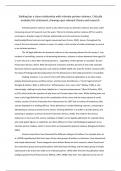Tentamen (uitwerkingen)
Essay Evaluating the Relationship Between Stalking and Intimate Partner Violence for MSc Understanding Criminal Behaviour Module
- Vak
- Instelling
This essay was written for the Understanding Criminal Behaviour module which is part of the MSc Forensic Psychology taught at the University of Lincoln, UK. The essay critically evaluates the relationship between stalking and intimate partner violence, with particular focus on attachment theory...
[Meer zien]




